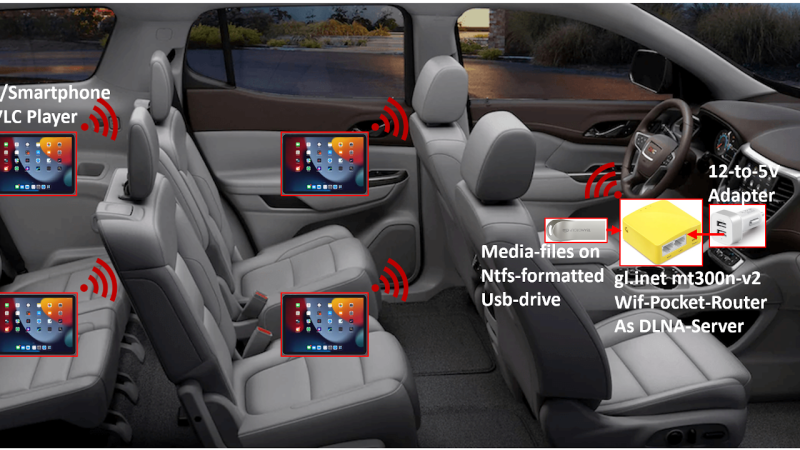A good amount of hacks can be done with off-the-shelf hardware – what’s more, it’s usually available all over the world, which means your hacks are easier to build for others, too. Say, you’ve built something around a commonly available portable router, through the magic of open-source software. How do you make the fruits of your labour easy to install for your friends and blog readers? Well, you might want to learn a thing or two from [Albert], who shows us a portable DLNA server built around a GL-MT300N-V2 pocket router.
[Albert]’s blog post is a tutorial on setting it up, with a pre-compiled binary image you can flash onto your router. Flash it, prepare a flash drive with your media files, connect to the WiFi network created by the router, run the VLC player app, and your media library is with you wherever you go.
Now, a binary image is good, but are you wondering how it was made, and how you could achieve similar levels of user-friendliness in your project? Of course, here’s the GitHub repository with OpenWRT configuration files used to build this image, and build instructions are right there in the README. If you ever needed a reference on how to make commonly available OpenWRT devices do your bidding automagically, this is it.
This is an elegant solution to build an portable DLNA server that’s always with you on long rides, and, think of it, it handily beats a typical commercialized alternative, at a lower cost. Want software upgrades? Minor improvements and fixes? Security patches? Everything is under your control, and thanks to the open-source nature of this project, you have a template to follow. There won’t always be a perfectly suited piece of hardware on the market, of course, as this elegant dual-drive Pi-based NAS build will attest.

















Gli.net makes some cool hardware. I know the Beryl model (sp?) Has an SD card slot that you can use for the same purpose, plus you can then plug a USB cellular modem into the USB port and share that with all the devices over the wireless access point.
I dream about mesh emergency network using car electric power too.
media is very nice but in emergency situation communicator or goverment web page will be more important
Or, you use a Pi and Jellyfin. Then your passengers can enjoy streaming out of your box with an app and all.
Good luck finding a 12V enabled Jellyfinbox that can do transcoding efficiently on the fly for N devices simultaneously
Most computers run on 12V anyway. It wouldn’t be hard to adapt something. Plus, the availability of tiny x86 machines would make this pretty trivial too. Handling a few devices would be realistic.
My box consists of a Pi CM4 with NVME SSD. A 12V to 5V power supply was no problem.
And all the media is already transcoded, to have a supported codec.
It is tested with 3 passengers, using the app on iPhone and Android, no problems so far.
Even though the DLNA consortium formed in 2003, this may be the first time I had heard of it.
So…
https://www.lifewire.com/what-is-dlna-1847363
I was wondering if the article was going to explain WTF is DLNA, thanks.
I thought these routers’ OEM firmware already came with (mini)DLNA server, or at least easily installable.
EDIT: Indeed, it comes or is easily installable.
https://docs.gl-inet.com/router/en/3/tutorials/multimedia_file_sharing
I literally built this exact same solution 2 years ago!
Use a powerpack and you’re your own walking server.
The “Mango” (GL-MT300N-V2) router is a pretty weak piece of kit, but it’s pretty cheap too.
GL-iNet GL-MT300N-V2 $29.90 USD on Amazon:
https://www.amazon.com/GL-iNET-GL-MT300N-V2-Repeater-300Mbps-Performance/dp/B073TSK26W/
GL-iNet GL-MT300N-V2 Homepage:
https://www.gl-inet.com/products/gl-mt300n-v2/
GL-iNet GL-MT300N-V2 Key specs:
Max. 300Mbps Wi-Fi speed (dual band)
128MB RAM, 16MB Flash ROM
Dual Ethernet ports
UART and GPIOs available for hardware DIY
Yeah, that 16GB of flash kind of shoe-horns you into OpenWRT. 300 Mbps WiFi is also limiting, especially in crowded band-space.
There are two Ethernet ports, so this little router might be a good fit when you want to bastion an IoT subnet with hardware.